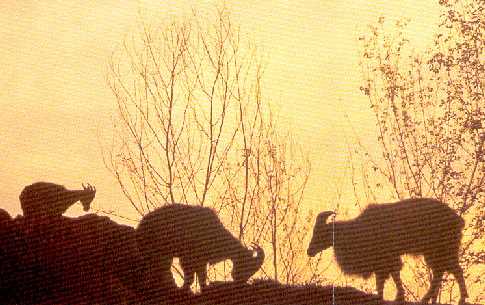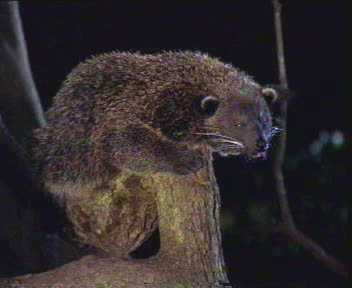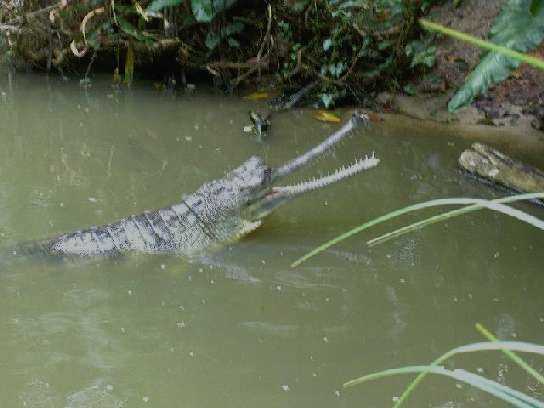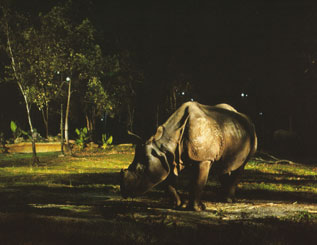|
Night
Safari Walking Trails
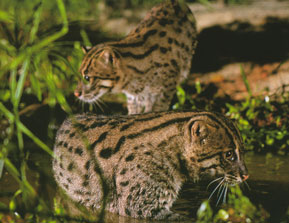

Animals
on the
Fishing Cat Trail
|
|
Animal
Name: Himalayan Tahr
Scientific
Name: Hemitragus jemlahicus
Range:
Narrow strip of southern
Himalayas, re-introduced to South Africa and New Zealand.
Habitat:
Higher mountain ranges,
between altitudes of 2500 to 4400metres.
Diet:
Grass, shrubs and leaves.
Social
structure: Lives in small
herds, active by day.
Life Span:
Wild - 15 years, Captivity - 21 years.
Conservation/status:
Not under threat, considered
a pest in New Zealand by livestock farmers.
Remarks:
The Himalayan Tahr was
introduced to New Zealand in 1904 for trophy hunting.
A pair of tahrs escaped from a South African zoo in 1930s
to breed in the Table Mountain area but this population
is small.
|
|
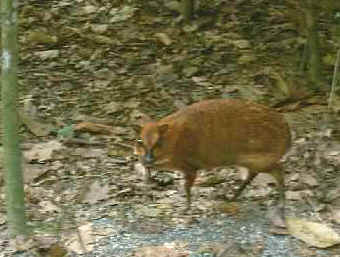
|
Animal
Name: Greater Mousedeer
Scientific
Name: Tragulus napu
Appearance:
Reddish brown color with
more white under parts, bigger and fatter than Lesser Mousedeer
Range:
South-east Asia
Habitat:
Secondary forests, especially
in lowland forests below 100metres
Diet:
Fallen fruits, leaf shoots
and fungi.
Social
structure: Usually solitary
Life Span:
Wild - unknown, Captivity - 14 years.
Conservation/status:
Not threatened
Remarks:
Mousedeer are not true
deer but a separate species of ungulate (hoofed animal),
have no antlers but males have longer canines protruding
out of upper jaws. They are portrayed as very intelligent
and wise animals (Sang Kanchil) in Malay folklore.
|
|
|
Animal
Name: Binturong
(or Bear Cat)
Scientific
Name: Arctictis
binturong
Range:
Southeast Asia, including
Indonesia and Borneo
Habitat:
Dense tropical and sub-tropical
forests, mostly in trees
Diet:
Leaves, shoots, fruits,
berries as well as birds, fish, small mammals and carrion.
Social
structure: Small
family groups consisting of parents and few young
Life Span:
Wild - 18 years, Captivity - A little longer.
Conservation/status:
Not threatened
Remarks:
Easily domesticated and
has been kept as pets by people living near the forests.
Can hang upside-down from a branch using its hind legs and
aided by its prehensile tail.
|
|

|
Animal
Name: Fishing Cat
Scientific
Name: Prionailurus viverinnus
Range:
From India to Southeast
Asia
Habitat:
Wetlands, mangrove swamps,
river creeks.
Diet:
Mainly fish, but very opportunistic,
will also hunt frogs, snakes, crustaceans, rodents, water
birds, will raid fish and poultry farms, hence becoming
pests.
Social
structure: Solitary
Life Span:
Wild - 10 to 15 years
Conservation/status:
Not threatened
Remarks:
Can swim, jump into water
to catch fish, has waterproof fur to keep body warm, has
the densest fur per square inch of all mammals.
|
|
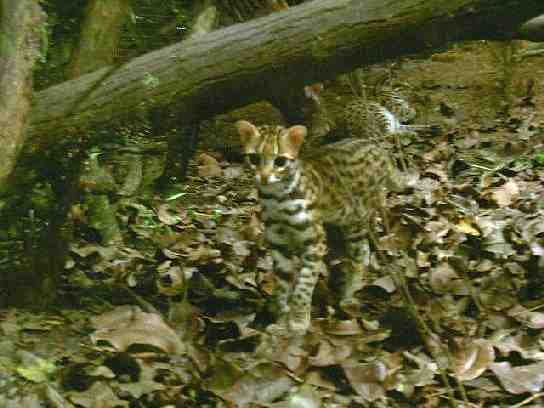
|
Animal
Name: Leopard Cat
(retired, now replaced by Pangolin)
Scientific
Name: Felis bengalensis
Range:
Northern India to China
and Siberia, Taiwan and Southeast Asia down to Indonesia
and the Philippines.
Habitat:
Forest floors and in trees
Diet:
Small mammals, small birds
and big insects.
Social
structure: Solitary
Life Span:
Wild - 10 to 15 years
Conservation/status:
Hunted for fur, might be
becoming endangered, highly endangered in Singapore.
Remarks:
Extremely fierce and almost
impossible to tame, often crossbred with domestic cats to
produce pet cats with the beautiful spotted coats. This
cross-breed is known as the Bengal Cat. Read more about
the Leopard Cat and Bengal Cat here.
|
|
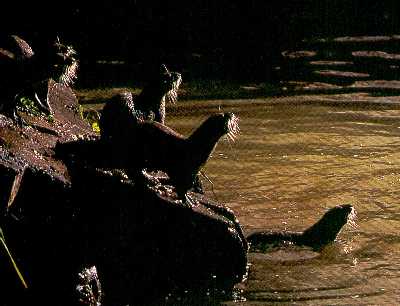
|
Animal
Name: Oriental Small-clawed
Otters
Scientific
Name: Aonyx (amblonyx)
cinerea
Range:
India to southern China,
southeast Asia, Indonesia and Borneo.
Habitat:
Wetlands, mangrove swamps,
river creeks, ponds, lakes, especially where there is some
tree cover.
Diet:
Mainly fish, also eats
crustaceans, shellfish.
Social
structure: Can be solitary
but more often in small family groups.
Life Span:
Up to 20 years.
Conservation/status:
Not threatened though they
are affected by water pollution.
Remarks:
Waterproof fur to keep
body warm, streamlined body designed for swimming, will
overturn rocks on riverbeds with front paws in search of
crustaceans. Can become very vicious when they gang up together
against even much larger intruders.
Read
more about
otters
here.
|
|
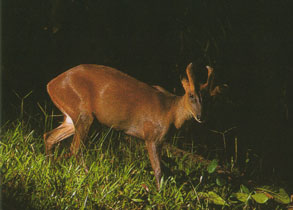
|
Animal
Name: Barking
Deer (or Indian Muntjac)
Scientific
Name: Muntiacus munljak
Range:
India and Nepal, Malaysia,
Sumatra, Borneo and Java.
Habitat:
Hilly areas and among dense
vegetation, ranging in altitudes for sea level to 1000metres.
Diet:
Leaves, fruit, bark, fungi.
Social
structure: Solitary or
in pairs.
Life Span:
Wild - 10 years, Captivity - 17 years.
Conservation/status:
Not threatened
Remarks:
Will
make a barking-like sound when danger is spotted, antlers
grow from above the eyebrows of males instead of on top
of the heads like typical deer. Small size and short antlers
good for dashing into bushes for safety. Highly regarded
by the royalty in Malaysia, are featured on the state emblem
of Kelantan.
|
|
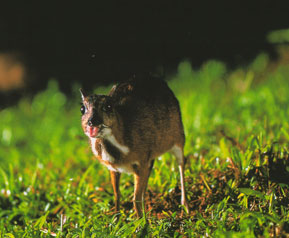
|
Animal
Name: Lesser Mousedeer
Scientific
Name: Tragulus javanicus
Appearance:
Greyish to dull brown color
with less white under parts, smaller and slimmer than Greater
Mousedeer
Range:
South-east Asia
Habitat:
Secondary forests, especially
in more upland forests
Diet:
Fallen fruits, leaf shoots
and fungi.
Social
structure: Usually solitary
Life Span:
Wild - unknown, Captivity - 14 years.
Conservation/status:
Not threatened
Remarks:
Mousedeer are in fact very
delicate animals and extremely timid, they can die of fright
easily or break their legs easily when fleeing haphazardly
from danger. They are prey to nearly all the predators in
the forest.
|
|
|
Animal
Name: Indian
Ghavial (or Gharial)
Scientific
Name: Gavialis gangeticus
Range:
Mainly in India and parts
of Pakistan
Habitat:
Fast flowing rivers.
Diet:
Mainly fish, sometimes
water birds and small mammals and carrion.
Social
structure: Solitary or
in small groups
Life Span:
Conservation/status:
Once hunted by the thousands
for their skins and body parts for traditional medicines,
deprived of homes when many fast flowing rivers were dammed,
now recovering slowly from conservation and captive breeding,
still endangered.
Remarks:
The tip of the snout on
the males swell during the breeding season. This swollen
part is called 'ghara', hence the name Gharial. The ghara
is believed to contain aphrodisiac properties. Gharials
sometimes swallow jewellery to help grind up food in their
stomachs, probably scavenged from human burial remains along
the Ganges river.
|
|
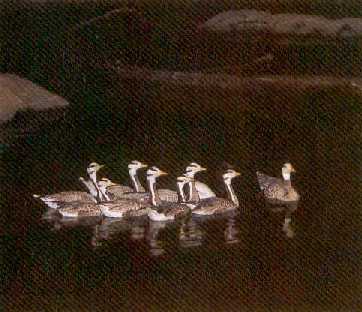
|
Marshland
Habitat I
Wetland birds
include the Cattle Egret, Cormorant, Masked Lapwing, Night
Heron, Purple Heron, Rajah Shelduck, Wood Duck, plus the
Flying Fox.
Marshland
Habitat II
White Pelican,
Bar-headed Goose (left), Cormorant, Night Heron, Rajah Shelduck
and Wood Duck.
See Marshland
Birds
at Animal Spotlight.
|
|
Animals
on the Rhino Walkway
The
Rhino Walkway
(unofficial
name) links the Fishing
Cat Trail
to the Leopard Trail,
which
is the
walking trail nearest to the East
Lodge and
Tram Station 2.
|
|
|
Animal
Name: Greater Asian One-horned
Rhinoceros (or Indian
Rhino)
Scientific
Name: Rhinoceros unicornis
Range:
India and Nepal
Habitat:
Swampy areas close to rivers
with tall elephant grass nearby.
Diet:
Grass, twigs, bamboo shoots,
water hyacinth and crops.
Social
structure: Partly solitary,
partly social and territorial
Life Span:
40 - 50 years.
Conservation/status:
Endangered and survives
in protected parks in India and Nepal.
Remarks:
Hunted for its horn which
is used in traditional Chinese medicine to cure fever. Rhino
horn is made up of highly compressed hair-like fibres above
a bony lump on the skull. Rhinos protect their skin from
sunburn and insect bites by wallowing in mud, keeping the
skin cool and forming a layer of protective crust on the
skin when the mud dries.
Learn
more about rhinos here.
|
|
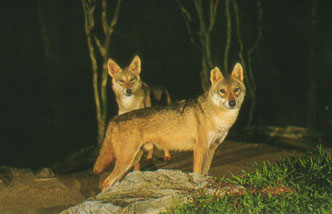
|
Animal
Name: Indian
Wolf
Scientific
Name: Canis
lupus
Range:
India
Habitat:
Dense forests,
near villages with livestock.
Diet:
Mainly ungulates
(hoofed mammals)
Social
structure: Highly
social, live in family groups called packs or sometimes
alone.
Life Span:
Wild - 10 years, Captivity - A little longer
Conservation/status:
Highly threatened,
due to loss of habitat and manís prejudice, frequently shot
by livestock farmers.
Remarks:
Wolf packs
are led by an alpha male and female pair, and only they
have the right to mate. The other pack members rank themselves
according to age. They help to hunt and protect the pups.
Wolves howl to communicate with distant pack members and
to signal their presence to other wolf packs, avoiding territorial
disputes.
|
|
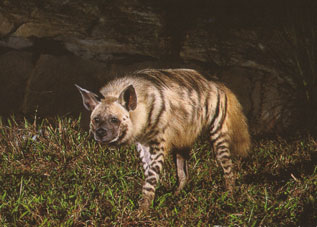
|
Animal
Name: Striped
Hyena
Scientific
Name: Hyaena hyaena
Range:
North Africa, Middle East,
India
Habitat:
Grassland, shrubs and rocky
mountainous areas.
Diet:
Mostly carrion, also hunts
small mammals, birds, eggs, reptiles, fruit and also rummages
garbage dumps.
Social
structure: Solitary or
in small family groups of 2 or 3.
Life Span:
Wild - unknown, Captivity - 25 years.
Conservation/status:
Though widely distributed,
densities are low and is endangered in North Africa. Numbers
are declining due to habitat loss and hunting but fortunately,
it breeds well in captivity.
Remarks:
Not as aggressive as its
spotted cousin, hunted in its range for its body parts which
are believed to have medicinal properties. Hyenas possess
very strong jaws, enabling them to crack open bones. They
also have highly acidic stomachs for them to digest even
bones and hooves which they will then regurgitate as pellets.
|
Acknowledgements
- Animal
Facts from Wildlife Fact Files,
classroom
sessions and informal interviews with zoology staff of WRS, Photos
from Night Safari.
Let's
go to the next trail, choose one!
Leopard
Trail
Forest
Giants Trail
Home
| Explore
| Rangersí Station
| Walking Trails
| Tram Ride
| Resources
|
©
2009 NSRangers.Tripod.com. All rights reserved.
|
|


